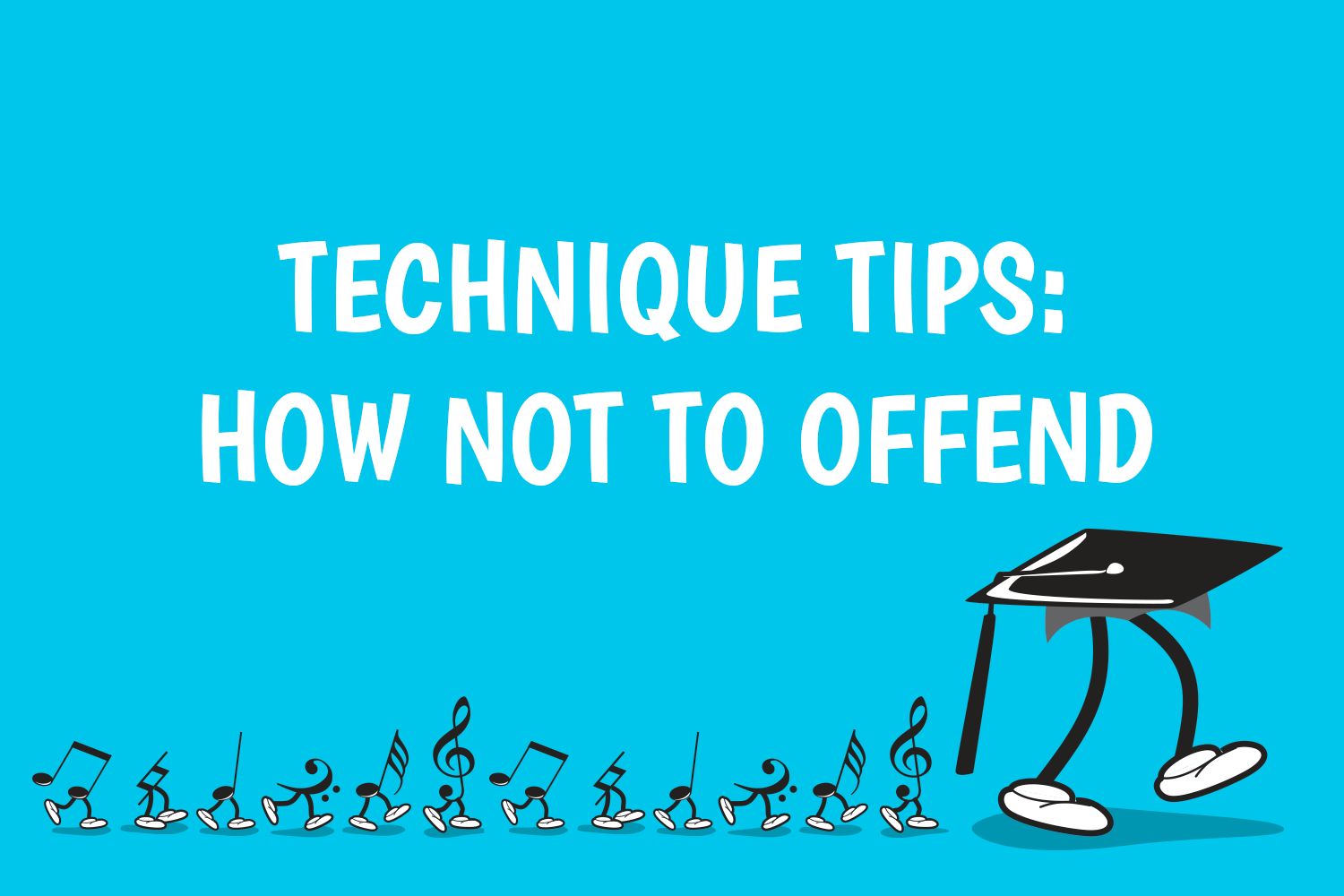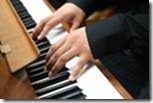Technique Tips: How Not to Offend


Technique is an incredibly subjective issue. Get 10 piano teachers in a room and you will have 10 different techniques. Dare to criticise someone else’s and you’re in for a long night. I’d like to start this article by describing three personal experiences, all to do with comments on technique.
Many years ago when I was a third-year Bachelor of Music student at the Sydney Conservatorium, I received an assessment report which made regular references to the shape of my fingers. The assessor of my performance (which had gone very well, by the way) seemed to be greatly concerned that some of my fingers were straighter than they should be. My teacher at the time, who had been working with me intensely on technique, was absolutely mortified that I should receive such comments (and indeed that they seemed to have affected my mark). My teacher felt that we were ‘way past that now’ and that a tertiary report should focus solely on the sound of the music (on which the assessor had mostly declined to comment).
I once had a student who came out of his piano exam with a report which praised his lovely playing and his musicality and tone and memory, but had frequent and quite scathing remarks about his technique. The examiner commented on his wrist position, his movement when playing double octaves (of which there were many, and which he played well), and his general finger technique – none of which affected his playing negatively and all of which the examiner clearly didn’t agree with. Despite the fact that he played well and did well, I subsequently lost this student, because the parent took the examiner’s word as gospel.
Recently I had a potential student contact me wanting lessons in her preparation for an A.Mus.A exam. She had only ever had bits and pieces of formal teaching and had decided it was time to be consistent. So we organised a trial lesson, and when she arrived I did my usual trick with potential students, saying I wasn’t quite ready and they should play some pieces and I’ll be back soon. (This gives me a chance to listen without them knowing I’m listening, and without them feeling inhibited.)
Well I heard some beautiful playing from the next room – very musical, a nice range of touch and tone. The passage work was very even. But when I came in to the room and sat down to watch… I was horrified! Her technique was, well, awful to look at. Flat fingers, no hand shape to speak of, flapping elbows – the works! BUT – she played beautifully. Somehow. The sound was great, and her technique, however aesthetically non-pleasing, worked for her. I was faced with a dilemma as a teacher: do I take this technique apart at this late stage of development, or roll with it and just concentrate (probably with my eyes closed) on the music?
The stories above all describe situations in which a particular technique, which is working well for one person, is displeasing to another. So this begs the question: when is it relevant and appropriate to criticise another’s technique?
I recently saw a post on Facebook from a piano teacher who had given his student a Shostakovich prelude to play. He had uploaded the video of the student playing it after only 2 weeks of learning – and it was totally amazing! Incredibly fast, even, balanced and wonderful. Most of the comments consisted of ‘wow!’ or ‘you’re such a lucky teacher!’ … but the comment that really got my attention was ‘Just tell him to keep his left wrist higher, otherwise it sounds great!’
This intrigued me. Why on earth was this random other teacher concerned about the height of the wrist, when it clearly did not inhibit the playing? Vladimir Horowitz plays with flat fingers. James Morrison plays with puffed cheeks. Should we criticise these incredible musicians just because it doesn’t look right?
Of course, there are times when a bad-looking technique is clearly inhibiting the performance, and this perhaps warrants some helpful advice from an examiner or adjudicator. For example: “Your semiquavers were quite uneven today – aim for a more curved finger shape when you play.” This is helpful. Even if the student had for some reason never been taught to play with curvy fingers, the comment is about the fact that the sound wasn’t good and was pointing out a possible solution. The teacher may wish to address the problem a different way, but the fact is that a problem needed addressing. This is a very different situation to one in which there is no fault with the sound, only the look – which means it comes down to a matter of opinion.
Examiners of the Associated Board of the Royal School of Music (ABRSM) are specifically instructed NOT to comment on technique, and in many cases they are actually ill-equipped to do so, even if they wanted to. This is because one examiner may spend the day examining a multitude of different instrumentalists, having never played any of those instruments him/herself. In ABRSM exams, it all comes down to how the performance sounds.
Yet many of my examiner colleagues (mostly AMEB and ANZCA) tell me they feel duty-bound to comment on technique if they feel it will ultimately let the student down (even if it hasn’t done so in that particular exam). If a young pianist is playing with sunken wrists and flat fingers, an examiner will be hard pressed not to say something about it in the report, because it is such an inefficient way to play. (Yes, Vladimir Horowitz manages it, but that doesn’t mean it’s a good idea to start off that way.) The trick here, I feel, is for the examiner to make it clear that any comments on technique are not a reflection on the mark given, unless that technique has been responsible for something going awry in the music. In other words – an exam mark or eisteddfod result should be based purely on what we can hear, and not on what we see.
In my lecture/demonstration entitled ‘The Inherited Student – Delight or Disaster?’, in which I discuss the trials and tribulations of inheriting students from inexperienced teachers, I ask the mostly-piano-teacher audiences to call out some areas of technique in which most teachers differ from one another. They usually come back with:
· Height of wrist
· Position of pinky
· Angle of arms/elbows
· Height of stool
· Position of fingers on the keys
· Movement of wrist
· Movement of thumb
But we then go on to discuss the elements that most – or even all – piano teachers would agree on:
· Straight back
· Supported feet
· Arm’s length distance from piano
· Curved finger shape
It appears that no-one would be offended if their students were picked up on any of those well-agreed-upon points!
But even so, one has to tread carefully in the commercial world, which is what I’ve been doing recently in developing the iphone app ScaleBlitzer. Since it is an app that motivates students to practice their scales and arpeggios, and is marketed as improving technique, it stands to reason that there should be technique tips within the app. However, none of the four agreed-upon tips above appears in any of the piano packs. Even a tip such as ‘play with curvy fingers’ could easily be frowned upon by teachers whose students then turn up with a very curved pinky (and who had perhaps previously been taught not to). And most of the agreed-upon tips refer more to the setting up of the sitting position, rather than something one thinks about and adjusts while playing. The ScaleBlitzer piano packs concentrate on practice methods which enhance evenness of touch and tone – while the teacher is the one who monitors sitting position and hand technique.
However, upon interviewing various woodwind, brass and string players about technique and practice methods, the feedback I got was that they would be delighted if ScaleBlitzer occasionally threw up a non-offensive, universally agreed-upon technique tip, something that teachers are constantly ‘nagging’ their students to do, such as:
· Think about your posture
· Think about your sound
· Play with a beautiful sound
· Play with a big sound (mostly brass)
· Think about your bow hold (strings)
· Make sure you play every note in tune (mostly strings!)
All of the above tips encourage students to think about and be aware of their playing, without being specific to any particular technique. So it’s ScaleBlitzer that can nag them, not the teacher. J
In conclusion: the fact that it’s possible to cause offence with specific technique instructions such as ‘keep your wrist higher’ or ‘use your whole arm’ is an indication that there is more than one technique that can work for any one person. I often use the analogy of Olympic swimmers, all of whom might have different coaches/techniques but any of whom might win the gold medal on the day, because their technique works for them. If we can remember this in the musical world, and perhaps not get so uptight about it as long as we sound good, everyone might be a bit happier. Although one thing I don’t know is… maybe the swimming coaches all go through exactly the same thing.
